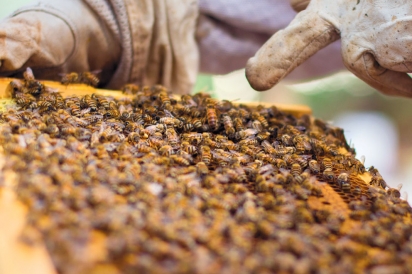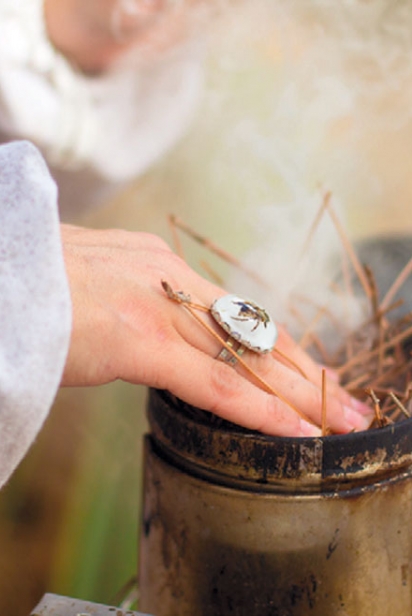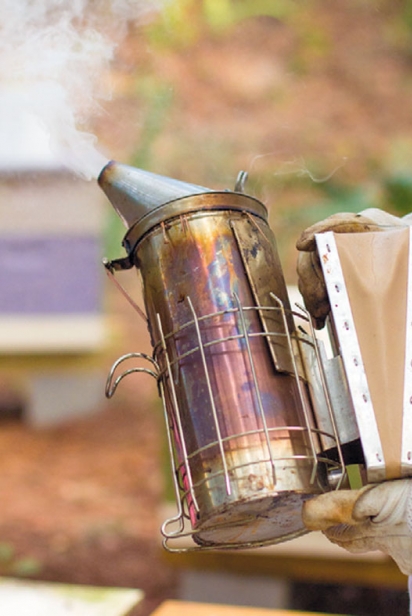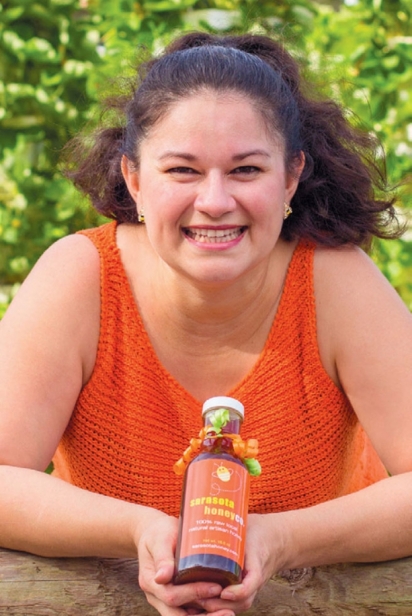Local Buzz
Sarasota Honey Company
“Would you like to come meet the girls?” says Alma Johnson when you meet her. You’re at Sweetgrass Farms off of University Parkway in Sarasota, so an invite to meet “the girls” is a little confusing. Who does she mean, exactly?
Turns out, those girls are Johnson’s bees.
Johnson, who operates Sarasota Honey along with her husband, Glenn, leads you past the gleaming hydroponic greens and strawberries at Sweetgrass to an area in the woods with around 40 bee colonies—each colony with about 40,000 to 60,000 bees, of which 90 percent are female.
Johnson talks about “babying” her bees by feeding them sugar water—not corn syrup like some larger growers might do—and vitamins. She also explains how her bee colonies are set up around different neighborhoods in Sarasota and Bradenton (see sidebar), giving each small-batch honey created a unique flavor. The result: great-tasting honey, and a clear connection between hardworking bees and the beautiful blossoming flowers and close-up-ready produce.
“Every strawberry that’s here [at Sweetgrass] is because one of my bees touched it,” says Johnson with pride. Sarasota Honey’s boosting the bee population at a time when colony collapse disorder and pesticides have wiped out a large percentage of bees around the world.
It’ll take more hobby beekeepers to once again grow the bee population around the world, Johnson believes.
If the story behind Sarasota Honey ended with Johnson’s passion for beekeeping, that’d be interesting enough. Yet there’s more.
Johnson, originally from Texas, became interested in beekeeping after fighting cervical cancer at age 30. That scared her enough to pay more attention to what she was eating and focus more on eating organically and from local sources. She started a garden at home but, due to lack of bees to pollinate it, she had to hand-pollinate. Although her early gardening efforts were tasty but not fruitful, she started to think more closely about her true passions—honeybees and helping children with special needs, which was her working background.
So, once Sarasota Honey was officially under way, Johnson began to work with young adults who have special needs, including Down syndrome and autism. Through Sarasota Honey’s partnership with Sarasota’s Community Haven for Adults and Children with Disabilities, the business has young adults who are beekeepers, while others help at the honey processing area. Still others help make beeswax candles or soap. Johnson also is involved with free weekly classes to help boost these young adults’ ability to manage money, go on job interviews, and live independently. Many feel more confident about themselves after their work at Sarasota Honey.
Johnson says she enjoys working with two often-misunderstood populations: those with special needs and the bees.
Some places where you can find Sarasota Honey include Sweetgrass Farms, the Phillippi Farmhouse Market, Phillippi Creek Oyster House, Sarasota Jungle Gardens, Simon’s Coffee House, and White Picket Produce. Johnson is also working with Whole Foods Market and Fresh Market to try and get on the shelves.
Sarasota Honey is partnering with Sweetgrass Farms to have a Honeybee Festival on March 12.
Pick Your Flavor
Not all honey is the same, as the folks at Sarasota Honey know well. Living here in Florida, you’ve probably heard of orange blossom honey—named for the citrus blooms that the bees help pollinate in certain areas of the state—or Tupelo honey, made in northwest Florida.
Larger honey makers may mix honey from a wide swath of geographical areas, but that doesn’t happen at Sarasota Honey. “That would be a disservice to the bees,” Johnson says. “Not mixing is how nature wanted us to have it.”
Johnson has almost 170 bee colonies set up all around Sarasota and Bradenton, from her own residential area around Sarasota Jungle Gardens to Anna Maria Island to Sweetgrass Farms near University Parkway to areas near I-75. All honey produced reflects the area where it’s from. Some recent batches include Sarasota Bay Wildflower, Bradenton Orange Blossom, and Anna Maria Wildflower. “You get the taste of that neighborhood,” Johnson says.
Each honey has a different flavor and color. Some are darker, some lighter—some milder, some more cloying. One thing for certain is it won’t taste like the generic mix you’ll find in those bear-shaped plastic bottles from the supermarket.










